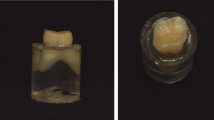Abstract
Fractures of metal-ceramic restoration pose an esthetic and functional dilemma both for patient and the dentist. Intraoral repair systems eliminate the remake and removal of restoration. Many intraoral repair materials and surface treatments are available to repair intraorally fractured metal-ceramic restoration. Bond strength data of various materials and specific technique used for repair are necessary for predicting the success of a given repair system. This study evaluated the shear bond strength of three different intraoral repair systems for metal-ceramic restorations applied on exposed metal and porcelain surface. One hundred and twenty metal discs (20 mm in diameter × 0.7 mm thick) were fabricated with nickel–chromium alloy (Mealloy, Dentsply, USA). Feldspathic porcelain (Duceram, Degudent, Germany) were applied over one test surface of the discs in the thickness of 1.8 mm followed by conventional firing. The defect, which simulates clinical failures were created in 1/4th area of the metal-ceramic discs. The metal-ceramic discs samples were divided into ceramic substrate (Group I, n = 60) and metal substrate (Group II, n = 60), according to the defect location. Then, samples of ceramic substrate (Group I) and metal substrate (Group II) were subdivided into A, B according to the surface treatments (A; roughening with diamond bur and B; abraded with 50 μ Al2O3) and repaired with one of the intraoral repair systems tested (a. Ceramic repair system, Ivoclar Vivadent; b. Clearfil repair system, Kurary, c; Porcelain repair system, 3 M ESPE). All the repaired samples were stored in distilled water at 37 °C for 24 h. After thermocycling at 6–60° C, all the samples were stored at 37 °C for additional 7 days. Shear bond strength of all the samples were calculated by using Universal testing machine. The mean shear bond strength values for the group I (A/B) were as follows: Ceramic repair system (9.47 ± 1.41/14.03 ± 2.54 MPa), Clearfil repair system (14.03 ± 2.32/14.64 ± 2.28 MPa), and Porcelain repair system (14.41 ± 3.96/14.86 ± 3.10 MPa). The mean shear bond strength values for the group II (A/B) were as follows: Ceramic repair system (9.42 ± 1.44/18.61 ± 2.60 MPa), Clearfil repair system (14.44 ± 3.23/14.98 ± 2.73 MPa), and Porcelain repair system (11.86 ± 2.24/13.24 ± 2.72 MPa). Air abrasion with 50 μm aluminum oxide particles is the preferred surface treatment. Porcelain repair system showed the highest shear bond with air abrasion for ceramic substrate and for metal substrate Ceramic repair system showed the highest bond strength with air abrasion as a surface treatment. This study suggest that the three repair systems tested are adequate for intraoral chairside repair of metal-ceramic restoration when air abrasion is used for surface treatment of the substrate (Ceramic repair system, Ivoclar Vivadent, Germany; Clearfil repair system, Kurary, Japan; Porcelain repair system, 3M ESPE, Germany).


Similar content being viewed by others
References
Haselton RD, Diaz-Arnold MA, Dunne TJ (2001) Shear bond strengths of 2 intraoral porcelain repair systems to porcelain or metal substrates. J Prosthet Dent 86:526–531
Galiatsatos AA (2005) An indirect repair technique for fractured metal-ceramic restorations: a clinical report. J Prosthet Dent 93:321–323
Libby G, Acuri MR, Lavelle WE, Hebl L (1997) Longevity of fixed partial dentures. J Prosthet Dent 78:127–131
Santos DGJ, Fonseca GR, Adabo LG, Cruz DAC (2006) Shear bond strength of metal-ceramic repair systems. J Prosthet Dent 96:165–173
Chung HK, Hwang CY (1997) Bonding strength of porcelain repair systems with various surface treatments. J Prosthet Dent 78:267–274
Appledorn ER, Wilverding MT, Barkmeier WW (1993) Bond strength of composite to porcelain with newer generation of repair systems. J Prosthet Dent 70:6–11
Thurmond WJ, Barkmeier WW, Wilweding MT (1994) Effect of porcelain surface treatments on bond strength of composite resin bonded to porcelain. J Prosthet Dent 72:355–359
Cobb SD, Vargas MA, Fridrich AT, Bouschlicher RM (2000) Metal surface treatment: characterization and effect on composite-to-metal bond strength. Oper Dent 25:427–433
Tulunoglu FI, Beydemir B (2000) Resin shear bond strength to porcelain and a base metalalloy using two polymerization schemes. J Prosthet Dent 83:181–186
Petridis H, Garefis P, Hirayama H, Kafantaris MN, Koidis TP (2003) Bonding indirect resin composites to metal: part 1. Comparison of shear bond strengths between different metal-resin bonding systems and a metal-ceramic system. Int J Prosthodont 16:635–639
Ozcan M, Sleen MJ, Kurunmaki H, Vallittu KP (2006) Comparison of repair methods for ceramic fused to metal crowns. J Prosthodont 15:283–288
Suliman AA, Swift JE, Perdigo J (1993) Effect of surface treatment and bonding agents on bond strength of composite resin on porcelain. J Prosthet Dent 70:118–120
Ozcan M, Neidermeier W (2002) Clinical study on the reasons and location of failures of metal-ceramic restorations and survival of repair. Int J Prosthodont 15:299–302
Chung HK, Hwang CY (1997) Bonding strength of porcelain repair systems with various surface treatments. J Prosthet Dent 78:267–274
Blatz BM, Dent M, Sadan A, Kern M (2003) Resin-ceramic bonding: a review of literature. J Prosthet Dent 89:268–274
Ferrando PJ, Graser NG, Tallents HR, Jarvis HR (1983) Tensile strength and micro leakage of porcelain repair materials. J Prosthet Dent 50:45–50
Bello AJ, Myers LM, Graser NG, Jarvis HR (1985) Bond strength and micro leakage of porcelain repair materials. J Prosthet Dent 54:788–794
Author information
Authors and Affiliations
Corresponding author
Rights and permissions
About this article
Cite this article
Jain, S., Parkash, H., Gupta, S. et al. To Evaluate the Effect of Various Surface Treatments on the Shear Bond Strength of Three Different Intraoral Ceramic Repair Systems: An In Vitro Study. J Indian Prosthodont Soc 13, 315–320 (2013). https://doi.org/10.1007/s13191-013-0270-x
Received:
Accepted:
Published:
Issue Date:
DOI: https://doi.org/10.1007/s13191-013-0270-x




